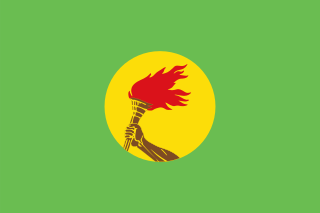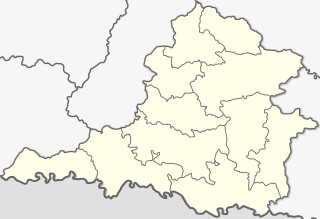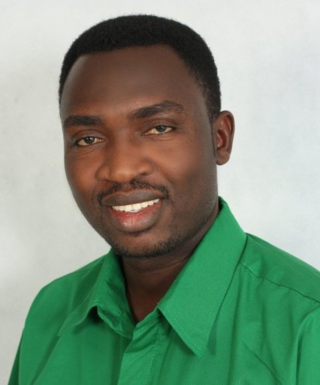Related Research Articles

The Nyamwezi, or Wanyamwezi, are one of the Bantu groups of East Africa. They are the second-largest ethnic group in Tanzania. The Nyamwezi people's ancestral homeland is in parts of Tabora Region, Singida Region, Shinyanga Region and Katavi Region. The term Nyamwezi is of Swahili origin, and translates as "people of the moon" or "people of the west", the latter being more meaningful to the context.

Mbeya Region is one of Tanzania's 31 administrative regions. The region covers an area of 35,954 km2 (13,882 sq mi). The region is comparable in size to the combined land area of the nation state of Guinea Bissau. Mbeya Region is bordered to the east by Singida Region, Iringa Region and Njombe Region. The region is bordered to the south by Malawi and Lake Nyasa. To the north the region borders southern Tabora Region. Lastly, Mbeya is bordered to the west by Songwe Region. The regional capital is the city of Mbeya. According to the 2022 national census, the region had a population of 2,343,754.

Mwanza Region is one of Tanzania's 31 administrative regions. The region covers a land area of 25,233 km2 (9,743 sq mi). The region is comparable in size to the combined land area of the nation state of North Macedonia. Mwanza Region is bordered to the north through Lake Victoria by the Kagera Region and Mara Region, to the east by Simiyu Region, to the south by the Shinyanga Region and to the west by Geita Region. The regional capital is the city of Mwanza. According to the 2022 national census, the region had a population of 3,699,872 and national census of 2012 had 2,772,509. Mwanza Region is the second region with high population in Tanzania after Dar es Salaam Region.
The Gogo also known as Gongwe(Wagogo, in Swahili) are a Bantu ethnic and linguistic group based in the Dodoma Region of central Tanzania. In 1992 the Gogo population was estimated to number 1,300,000..

Protein A is a 42 kDa surface protein originally found in the cell wall of the bacteria Staphylococcus aureus. It is encoded by the spa gene and its regulation is controlled by DNA topology, cellular osmolarity, and a two-component system called ArlS-ArlR. It has found use in biochemical research because of its ability to bind immunoglobulins. It is composed of five homologous Ig-binding domains that fold into a three-helix bundle. Each domain is able to bind proteins from many mammalian species, most notably IgGs. It binds the heavy chain within the Fc region of most immunoglobulins and also within the Fab region in the case of the human VH3 family. Through these interactions in serum, where IgG molecules are bound in the wrong orientation, the bacteria disrupts opsonization and phagocytosis.
Gogo is a Bantu language spoken by the Gogo people of Dodoma Region in Tanzania. The language is spoken throughout Dodoma Region and into the neighbouring district of Manyoni.

Zaire competed at the 1984 Summer Olympics in Los Angeles, United States. It had been 16 years since the previous time that the nation was represented at the Olympic Games as Congo-Kinshasa.

The 250 or so "Narrow Bantu languages" are conventionally divided up into geographic zones first proposed by Malcolm Guthrie (1967–1971). These were assigned letters A–S and divided into decades ; individual languages were assigned unit numbers, and dialects further subdivided. This coding system has become the standard for identifying Bantu languages; it was a practical way to distinguish many ambiguously named languages before the introduction of ISO 639-3 coding, and it continues to be widely used. Only Guthrie's Zone S is (sometimes) considered to be a genealogical group. Since Guthrie's time a Zone J has been set up as another possible genealogical group bordering the Great Lakes.
Protein G is an immunoglobulin-binding protein expressed in group C and G streptococcal bacteria much like protein A but with differing binding specificities. It is a ~60-kDA cell surface protein that has found application in purifying antibodies through its binding to the Fab and Fc region. The native molecule also binds albumin, but because serum albumin is a major contaminant of antibody sources, the albumin binding site has been removed from recombinant forms of protein G. This recombinant protein G, either labeled with a fluorophore or a single-stranded DNA strand, was used as a replacement for secondary antibodies in immunofluorescence and super-resolution imaging.

Waling Municipality, the heart of Syangja, is a small valley covered with hills formed on 27 January 1997 by merging of the then three VDCs namely Waling, Dhanubase and Pekhubaaghkhor. It is a town and municipality in the western hilly region of Nepal. It is in the Aadhikhola valley in Syangja District, Gandaki Zone of Nepal. Waling will be the first municipality to have houses all coloured with pink and will be named as Pink City. Waling has grabbed an award for the best municipality of the country.
The Northeast Bantu languages are a group of Bantu languages spoken in East Africa. In Guthrie's geographic classification, they fall within Bantu zones E50 plus E46 (Sonjo), E60 plus E74a (Taita), F21–22, J, G60, plus Northeast Coast Bantu. Some of these languages share a phonological innovation called Dahl's law that is unlikely to be borrowed as a productive process, though individual words reflecting Dahl's law have been borrowed into neighboring languages.

Endiandric acid C, isolated from the tree Endiandra introrsa, is a well characterized chemical compound. Endiadric acid C is reported to have better antibiotic activity than ampicillin.
Kimbu may be:

Hamisi Andrea Kigwangalla is a Tanzanian politician for the Chama Cha Mapinduzi (CCM) party and Member of Parliament for the Nzega constituency since 2010. After 2015, the Nzega constituency was split, and as a result, he took over as a member of parliament for the newly formed Nzega Rural following the 2015 general elections.
Barem (Brem), also known as Bunabun, is a Papuan language of Sumgilbar Rural LLG, Madang Province, Papua New Guinea.
Kimbu is a Bantu language of Tanzania. In 1992, use of Kimbu was declining but still in regular use in certain contexts. As of 2018, most children of Kimbu speakers learn Swahili as a first language, and do not learn Kimbu well.
The men's lightweight event was part of the boxing programme at the 1984 Summer Olympics. The weight class allowed boxers of up to 60 kilograms to compete. The competition was held from 29 July to 11 August 1984. 40 boxers from 40 nations competed.
Ogechi Adeola is a Nigerian business studies academic. She is the associate dean of business administration at the University of the People and associate professor of marketing at the Lagos Business School.
References
- ↑ Ethnologue [ dead link ]